Dubious about the Philippines

*Subic Bay*
We hadn't originally planned to enter the country in Subic Bay, but a number of necessary repairs and the wind direction changed that decision. We tied alongside a pontoon so we could rinse all the salt off the boat, do laundry, refill our water tanks and make a number of repairs to recover from the damage we incurred on the passage from Hong Kong - frayed backstay, ripped dodger, and broken lifeline, bow netting and topping lift.

We encountered a warm welcome as we pulled into the dock and immediately had a nice circle of cruising folks to hang out with. I can't tell you how excited we've been to encounter fellow cruisers for the first time in ages. Cruising is so much easier with fellow cruisers around. A number of them were French speakers so we found ourselves in the Philippines, drinking Pastis, a French liqueor and me practicing my French. And we had a great paella party in fine company.

You never really know what you'll end up with at the end of a passage and that is certainly not what we imagined we'd be doing upon our arrival in the Philippines. Folks on the French Canadian boat next to us bought their boat in Japan and sailed through Japan and then Taiwan before touring around the Philippines, so have been a great source for information and gave us a huge stack of charts to fill in any gaps we had in our collection.

We whittled away at our project list in the mornings and then ran errands and finished the day with Pastis and good conversation and often a meal with our friends next door. The weather was gorgeous and we could see the hills in the distance which was a nice contrast to the low visibility of Hong Kong; It was clear and warm, with a nice breeze to keep the boat cool and comfortable. And the sunsets were spectacular.

Many may remember that Subic Bay was the location of a US Navy base for many years. The base closed in 1991 yet its presence is still in strong evidence in Olongapo, the main town at the former base location. Inside the gate of the old US Navy base, where we were moored, is a little like a country club, with restaurants, duty free shops, beach bars and clubs and some wide open spaces. We had little incentive to leave our little insular world. Outside the gate lies a typical crowded, yet relatively prosperous, dusty and littered 3rd world town. The dramatic difference between inside and outside the gates reminded us of the contrast between Kwajalein and Ebeye, where the Marshallese workers lived, yet Olongapo was much dustier and busier with more vehicles and pedestrian traffic. The streets are filled mostly with "jeepneys" and "tricycles" plus the occasional regular car.


Jeepneys function like buses with regular routes and stops, and look like pimped up jeeps of a bright primary color (depending on the route they travel) with lots of chrome, and often a crucifix hanging from the rearview mirror. They reminded me of the old ZZ top cars, but more souped up. Tricycles, a motorcycle with a side car that two people can squeeze into, act as taxis that can be hired to go to a specific place within a certain range depending on its color coding. No muffler means they are often loud. We've noticed as we've travelled that the jeepney and tricycle styles are unique to each town. (In Panay, the tricycles are actually bikes.) We nearly got run over by countless tricycles soliciting our business - "Tricycle, Sir?" "Tricycle, Ma'am?"



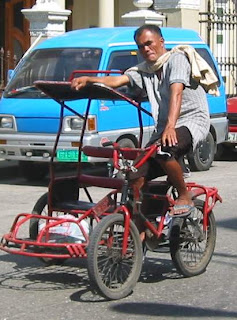
Funny thing was they often solicited our business while they were completely full with passengers, though I think that their riders were often just family who would get off if we seemed interested. We encountered few people walking on the streets; It seems the Pinoys, as the Filipinos call themselves, take tricycles even short distances. (If you kill or maim your potential customer, does it help business? Maybe so - they're probably hiring a jeepney because they are afraid of getting run over en route otherwise!) We're usually keen to stretch our legs after being aboard, but the heat does make a long walk a bigger expedition.

Most of the population seems to be under the age of 20. That means rap and hip hop music is big and karaoke, known here as "videoke", is popular as well. We can often hear the strains of videoke wafting across the water. Even the tiniest of towns seem to have a videoke bar. The unfortunate part is that the accompaniment often doesn't come through nearly as loudly as the out of tune voices. Lots of people sing as they go about their work and many have fine voices. But the delusion of imminent discovery and fame is more widespread than the talent! Around town, a cacaphony of bright colors and loud noises can be overwhelming on the street or in a mall as they compete for our attention. World affairs don't make the news as much as infotainment. When school lets out, town becomes significantly busier. School uniforms look very formal with the white shirts and ties with long skirts or pants. Everyone else wears mostly shirts, shorts and flip flops or a work uniform. The younger Filipinos are tiny. Most people seem to be either young or old, as though they make the transition overnight, an impression we've gotten since we see few that occupy the intervening years. We have heard that 20% of the population is away working overseas most of the year and that may explain the distinct gap between old and young that we see in the population. Many Filipinos leave their children with their "lolas" and "lolos" (grandmothers and grandfathers) while they work abroad and send money and packages home.

Most everyone in the Philippines speaks English, though most locals speak Tagalog amongst themselves. Junk and snack food is abundant and we see it piled high in everyone's grocery basket. Food here is cheap but heavy and fatty, so while we are tempted to dine out rather than deplete our relatively expensive ingredients aboard, we quickly tire of the Filipino options available in most restaurants. Fried foods, such as pork skins, pork and onions, and meat with heavy gravies are popular with less emphasis on fresh vegetables. Drinks cost as much as many main dishes, though drinks are what we want most to rejuvenate us in the dusty heat of town. Fresh mango and pineapple shakes are a big treat for us and we can't help but indulge. Fresh mangos have been heavenly here. Internet cafes are everywhere, and an hour of internet time costs between 25 and 40 pesos, mostly less than $1USD though connection speeds are usually slow. Everyone seems to have a cell phone and text messaging is cheap and popular. DVD movies come 8 movies to a pack for about two dollars, so we've almost tripled our movie collection with the purchase of 3 DVDs. We hear that lots of people watch them and then return them, turning it into 8 movie rentals for the mere loan of a couple of bucks, but not everyone can get away with that. You've got to have your local connections.
Our desire to explore has been dampened by feeling like a walking wallet or rip off target. We obviously do not look Filipino and consequently are singled out as ideal to rip off, not that everyone around here doesn't have that opportunity. We were shocked to hear that a Filipina woman we knew had to get a visa because she also holds a passport from France. If being a citizen with a passport doesn't give you the right to stay in your own country without a visa, what exactly does it get you? Just another opportunity to get hassled and ripped off, I guess. In this country, it all seems to come down to being constantly on guard against cheating and then using personal connections to weasel out of any issue that might come up at the whim of someone in a position of power who wants to abuse this power to extract some cash from their target. Things are quoted in dollars or in pesos, and the constant switching between the two currencies offers opportunities for "mathematical errors". Clarifying things sufficiently to remove the wiggle room is just about impossible. There's always one more question we didn't ask or one more item they failed to mention. We find relaxing nearly impossible under these conditions. Yet we did have a very positive experience getting a new dodger and awning made by an honest, hardworking man for a small fraction of what it might have cost nearly anywhere.

We had a nasty dressing down from an official who we refused to pay the $50 he demanded, with him just about spitting in our faces and throwing every insult at us that he could conceive. We knew we were not required to pay it and also knew that if we did, several other officers would be down shortly to request $50 each for themselves. That incident along with an upleasant one at the immigration office the day before and the outrageous calculation of our marina fees nearly caused us to just leave the country (without clearance) in anger. We were beginning to reach the conclusion "This harassment isn't going to stop until we leave the country, is it? Who needs this crap? Why don't we just sail to Kota Kinabalu, Brunei or Singapore instead?" The negatives were well outweighing the positives at that point and we were intensely frustrated. We'd finished all our repairs and were stowed and ready to move on anyway. But our cruising friends strongly encouraged us to give the Philippines another chance and sail with them to Puerta Galera, where we'd find a more pleasant atmosphere and where a former coworker was excited to meet up with us. So we sailed on through the night into the notoriously windy Verde Island passage finding ideal conditions, with pleasantly light winds and flat water. The scenery along the way was very pretty, with peaks like that of the Society Islands of French Polynesia or Hawaii.
*Puerta Galera*
We anchored in the large bay of Puerta Galera rimmed by turquoise water next to a white sandy beach. Several sandy beaches and reef patches in the distance intrigued us. We enjoyed the peace of just being at anchor in a pleasant environment, with a nice breeze blowing through the boat to keep us cool. Sprinkles from the clouds that clung over the mountain peak beside us occasionally interrupted the bright sunshine that fed our solar panels and charged our batteries. We snorkeled some giant clams on reefs nearby to cool off on the days when the breeze was light. We often spotted a turtle on the water surface nearby as we sat in the cockpit or while rowing or sailing our dinghy. We watched dinghies and windsurfers practicing all around us. We rigged up our sailing dinghy and sailed around the big bay and were invited to join their racing. We raced Mirrors, an 11 foot dinghy, similar to ours. We won handily but not without paying some dues. We had these horrible cleats that were challenging to release and frequently recleated themselves in the middle of a tack or jibe . . . and were also located right where I needed sit or hike. I was shocked later to notice the bruises on the back of both my calves and blisters on my heals from where my legs and feet rested while I was hiking out. Usually I am lucky and don't see many bruises from racing as some do, but we were trying to hike out in the windy choppy conditions and were sliding all over the place as the boat filled with water flying over the gunnels and for which we had no bailer. We lost the outhaul during a prestart maneuver, but fortunately they delayed the start for us. (Ah, loaner boats!) Garth broke his sunglasses when I whacked him in the face with my fist during a tack and then he ripped the pocket in his shorts. But we had a great time. As afternoon spilled into evening we celebrated with beers and appetizers at the Puerta Galera Yacht Club, chatting with our competitors who were from all over the world. On the weekend we watched a two day windsurfing regatta from the cockpit, with over 25 competitors, something we certainly didn't expect to see in the Philippines. The competitor's ages ranged from probably 9 to about 65. Seeing the line up at the start was fantastic, and we loved watching them maneuvering around the marks. The fleet spread out pretty quickly with a wide range of skill levels, but there were some pretty good sailors in the group.

The town of Puerta Galera is the usual dusty, 3rd world affair, and we wandered a little in several directions along the mostly dirt roads. During our visit, workers paved one side of the road, but construction came to a standstill after that, a common occurance around here. Third world towns are often an eyesore and we have now seen so many, that they no longer hold much interest for us and we've begun to dread them.

Along the waterfront is where all the yachties and expat retirees spend most of their time and the hawkers ply their wares (necklaces, DVDs and sunglasses mostly) to folks seated along the waterfront restaurant tables. (Too bad they don't come around offering the delicious fresh ripe mangoes, pineapples and mangosteen. They'd have a ready sale.) After the first few days we graduated from tourist status and then few solicited us while we were dining. While there were lots of yachts on moorings in Puerta Galera, none were passing through as we were. Most are the parked yachts of retired cruisers who've established a life in Puerta Galera. (We did encounter a race boat from Hong Kong - Strewth, the skipper of which had just won the Sidney Hobart Race that races from Sydney to Tasmania, Australia each Boxing Day. When we had cocktails with them, we discovered that knew all kinds of people in common in Hong Kong and we had fun talking about a place we so enjoyed and the people we've had such fun with.)
The Philippines in general and Puerta Galera in particular is a place where some expats like to retire because their money goes quite far. In fact the Lonely Planet guidebook reads "Today Puerta Galera is something of a haven for foreign, alcoholic retirees." A number of older males seem to hold court each afternoon with a San Miguel or 8 and pontificate on the state of world politics until their pubescent Filipina wives and small children come to collect them and drag them home for dinner. There are few decent jobs here so along with bloated government, the sex industry is pervasive. We've read that the percentage of sex workers exceeds the percentage of Filipinos working in manufacturing, and nearly 25% of them are underage. Marrying a foreign retiree, regardless of whether he's old enough to be your father or grandfather, or being a mail order bride offers an attractive alternative. Client customer type arrangements are by nature manufactured relationships but I suppose they can lead to love. I aspire to interact with people on a real level as fellow human beings but that is often hard to achieve when such there are such large differences in lifestyle or economics between people and the locals are trained to regard us as customers. In countries where the locals see few expats we usually have a better experience since we find they are not yet jaded, seeing us as merely a potential source of income. We were constantly solicited with "Sir" or "Ma'am" while we were in town and to me it felt like a barrier - a reminder that we were not interacting as equals. Getting away from folks who only deal with tourists as customers can be so refreshing when it does happen. Part of our adventure is appreciating cultural differences as we travel. Yet, the Philippines we've seen so far has not demonstrated a strong culture of its own but rather more like a copy of the Hollywood packaged US hip rap culture. Little spanish influence remains except for the names. (We've been seeing a pervasive invasion of US movie culture overtaking local customs more commonly as we've travelled more recently, particularly in third world towns or cities.) We miss the richness of diversity and feel a certain disappointment when we don't find a strong local cultural tradition in places we visit.
One of the most interesting aspects of the Philippines we've noticed so far is the styles of boats that are used for fishing and ferrying people around the vast islands that make up this country. The local style of boat is called a bangka. Bangkas are very narrow with high pointed bows and sterns and bamboo outriggers strapped to each side of the hull, giving them the gangly look of a spider. The outriggers lightly touch the water and gently balance the boat as its weight shifts. The bangkas seem to be very energy efficient and create a tiny wake even at high speeds.
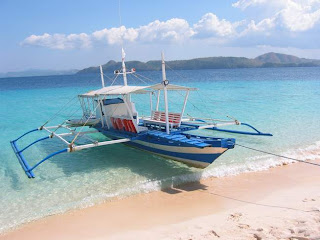
The outriggers make coming into the pier a bit awkward, and make pulling close alongside another boat nearly impossible. In Puerta Galera, brightly painted bangkas line the waterfront Med-moor style, dropping a stern anchor as they came in, then used bamboo poles to help maneuver the boat at slow speeds to park in tight spots alongside other bangkas. The larger passenger carrying bangkas have low flat roofs to keep the sun off its passengers, with side curtains to offer additional shade as needed. Atop the flat roofs sit emergency bamboo rafts, like the ones we built with the kids when I was leading youth adventures, but these ones are painted a bright orange. Of course, in the event of an emergency and need to abandon ship, about 4 people would be able to fit board the raft and the rest of the 25 odd passengers would be fresh out of luck.

Despite the often bright paint, the sleekness of the bangkas makes seeing even the biggest ones from a distance challenging. The tiny natural wood fishing bangkas are nearly invisible on the horizon and when paddled are nearly silent as well. We often hear a bangka from a great distance, due to the lack of a muffler on their cannibalized automotive engines, but then have trouble locating the source of the noise, unless the helmsman is wearing bright clothing. The helmsman typically steers from a standing or sitting position in the center of the bangka using an incredibly long hiking stick. When the helmsman is standing, the bangkas are usually a little easier to see but initially they look like a floating buoy until we get much closer. The ones not under power present a navigational challenge and require we keep an especially good look out. The sailing bangkas, called Paraw, are delightful to watch. Unfortunately, so far none have sailed close enough for me to get good photos of them.

We tried to hook up with some friends while we were in Puerta Galera, so stayed longer than we had originally planned. But we were keen to explore some other areas of the Philippines, where most cruisers said were their favorite Philippine spots: Calamian Islands and Apo Reef east of Palawan, so we finally got underway again. We watched the mountains pass by as we sailed west through Verde Island Passage in beautiful sailing conditions, with clear sunny skies, and the wind behind us. Bright sun highlighted the higher mountain peaks and cast shadows on the valleys where trees nestled, calling to attention their contours and the grassy plains in between. As the sun moved behind them, their silhouettes created another picturesque effect. As we exited Verde Island Passage and turned south, the wind died. We pulled into a pretty anchorage nearby, where a number of fishing bangkas were stopped. We watched the fishermen use masks to spot fish in the water, leaning over the sides of their tiny boats periodically, continually playing a hand line. Another set on a larger boat had people dive using scuba equipment or a hooka rig (hoses pumping air from a compressor aboard the boat). The water clarity was astounding but the anchorage offered little protection from nearly invisible swell curving around the point and made for a rolly though attractive spot for the night. At dawn when we got up to leave, the fishermen were gone. Light winds made our progress slow towards our preferred destination, turning a 2 day sail into a 3 day one. In this anchorage and the next we had a clear view to the west, perfect for enjoying a green flash and yet another beautiful sunset with intense oranges and pinks as the sun descended low in the sky.

*Apo Reef:*
We worked hard to get to famous marine sanctuary called Apo Reef, sailing for days in light winds and calm seas and ultimately having to motor to make it into a safe place for the night. Sailing between Mindoro and Apo Reef at night was unappealing due to a large number of unlit oil drums anchored around to serve as fish magnets (or fish attracting devices - FADs) with no moon. After such light winds all the way there, as often happens, the wind picked up shortly before we arrived. As we got close, we could see the irridescent hue of what looked like a swimming pool on the horizon and the same color reflected in the clouds that hovered above. But that inviting turquoise water was too shallow to offer safe anchoring for our 6.5 foot keel boat. So we tied up to a mooring ball, an orange painted steel oil drum, on the north side of Apo Island near a pretty sand spit that protected us from the chop that was coming up from the fresh south winds. The water depth went from over 100 feet to 25 suddenly as we arrived at the mooring. Clearly the moorings made staying over night here possible in what would otherwise be a nearly untenable anchorage. A beautiful white sandy beach lined the shore and looked very inviting in the afternoon sunlight. There was no sign of anyone on shore, though we saw what looked like a canoe in the distance pulled up near the sand spit. We were amazed at the water clarity. From the cockpit, we could watch tons of fish swimming and see sandy patches, bits of coral and then a very steep drop off below the boat. We immediately hopped over the side with our snorkel gear, excited to cool off after a long hot day and to look around. Our snorkel was brief in the fading light. We were amazed to be able to see the schools of fish and the bottom from the cockpit even as night fell. We were exhausted from several previous nights of poor sleeping conditions in rolly anchorages and were relieved to have finally arrived.
Yet relaxing was not in the cards for us that night. We spent a harrowing night, rolling our guts out as the wind and current shifted . . . and then doing emergency management and worrying. First the boat swung around and the steel mooring ball dragged along the side of the boat and got tangled between the dinghy and the wind vane on the back of the transom, just as we were settling to sleep. The waves were unusually choppy and moving around on the boat was scary in the moonless dark because we were getting thrown around a bit. Then we finally got that all straightened out by rigging the spinnaker pole to hold the mooring buoy away from the boat, a trick that works in many situations. But not all . . . At 1 in the morning the wind and waves came up from a different direction and the pole began snapping against the headstay and bow pulpit, making a lot of noise. We knew we couldn't ignore the stress of that on the equipment, even if we could bear the noise, so we unrigged the spinnaker pole. The boat was bouncing around pretty violently, still making work on the bow difficult. We hoped the new wind direction and current would hold us away from the mooring ball but there was always a chance another change could again spin us around and tangle us up again. We wished the dinghy wasn't in the water, but the wave action made bringing it aboard at that time incredibly difficult in the darkness. At 4am, Garth woke up to another funny sound. The tide had gone way out and we were hearing the waves crashing against a surface reef that we had figured had plenty of water when we tied up. With the new wind direction, it was now behind us with only about 20 feet to spare. While we were dying to clear out right then, we were uncomfortable doing anything in the pitch black darkness, when a single mistake could be much worse than our current situation. So we watched and waited until we could get the hell out of there at dawn. Such fun. The cruising lifestyle, while it offers unique opportunities for adventure, often makes you appreciate the smallest things in life, like a good night's sleep, a good meal, a long shower. No, it's not all umbrella drinks in the cockpit watching the sunset . . . sorry to break the news.
*Busuonga*
We sailed on at dawn for Busuonga, 35 miles southwest in light but pleasant conditions.

We pulled into a bay, where a resort reputed to welcome cruisers was located. And welcome us they did. Like, Musket Cove in Malolo Lailai, Fiji, the resort offers yachties an oasis, including discounts to yachties on food and beverage purchases, a nice pool, a game room with satellite TV and library alongside a beautiful sandy beach and calm anchorage. We were ready for a respite, and relished the pool, the umbrella drinks, and nice cuisine and we had the place nearly to ourselves. We played Mexican Train, a popular cruiser game, that we've thoroughly enjoyed with so many friends in the past, but this time we didn't have anyone else around to play.

A fully reciprocal sister resort just around the corner offered another oasis to explore, with regular transportation by bangka between the two resorts. The snorkeling right off the resort featured an impressive array of clams, with mantles in vivid colors of purple, turquoise and pink. Plus diving and exploring packages - wild animal park, reef and wreck dives - entice us into splurging to recover from what seems like months of sacrifice, as we've faced conditions that have sorely tested our love of this cruising lifestyle. From pauper to king suddenly.

So here we are, escaping from interacting with anyone but locals accustomed to catering to the needs of the sophisticated tourist and, of course, the tourists themselves! Now all we need is some friends to share our oasis with! A Spanish boat pulled in and we enjoyed their company for a few days and were surprised when we realized we'd spent two weeks! We were running out of supplies, set about heading to Coron, the nearest town, where we could replenish our boat stores and do some wreck diving.
We made our way down the coast to Coron Town in two *long* days. (How does a sailor know which direction his destination lies in? Why it's the direction from which the wind is blowing, of course!) We encountered challenging sailing - dead flat calm and no wind and then suddenly wind on the nose and nasty waves that threw us about and made us feel mildly out of control. Upon arriving in Coron town, we had to navigate coral patches sprinkled throughout the harbor before we could settle in on a spot to anchor. We were forced to motor so we could arrive while we still had the visibility to spot them. Once we got in we found ourselves in yet another dusty dilapidated, blisteringly hot town. From nearly the moment we stepped ashore, we were hassled by a zealously friendly self appointed "tour guide" who wanted to show us his cousin's store - every 10 minutes or so - for what seemed like most of the afternoon. He stalked us all over town and wanted to know our life's history and how we could be so rich as to own a yacht and not work for so long. Try explaining what Venus is like to someone from Mars. A mistake . . . He wasn't listening . . . we were just a walking wallet . . . We needed propane and groceries, but getting either wasn't going to be easy. And we were dripping with dirty sweat and starting to feel a bit depressed: all that hard work . . . for this? Over a cool drink at a shady restaurant overlooking the water, we finally came up with a plan for seeing some sights and getting our chores done, and we pulled ourselves out of our funk. To complete our chores and still have time to do something else besides, we buckled down.
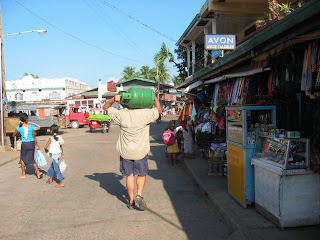

Battles during World War II left an impressive number of wrecks not far from Coron and once we finished our projects, we signed up to see two of them on a day long bangka trip which included lunch. We had the most amazing penetration wreck dives of a Japanese sea plane tender and an oil tanker in nearly 80-100 feet. We saw a turtle and lots of lionfish, beautiful soft coral, barracuda, shark, triggerfish, wrasses plus countless other sealife I have yet to learn the names of and much that we've never seen before. I really got a charge out of swimming in and out through portholes and hatches. On our second dive we had a ripping current, but as a result the coral was especially vibrant and beautiful.

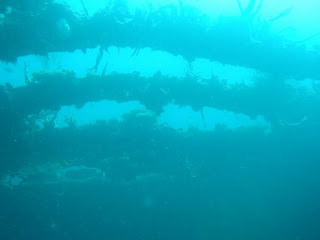
We spent a delightful afternoon amidst a varied group of foreigners, including someone who lives in Osaka, who we hope to see while we are in Japan. After such incredible dives, we were pretty jazzed about doing more wreck diving here, but were running out of time on our visas and the nearest immigration office was 200 miles away.
We took our dinghy over to a limestone island across from town to see a semi-freshwater lake.
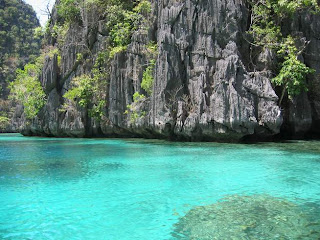
WOW!!!! Some of the most incredible scenery we've seen!

We pulled our dinghy into an enclosed bay, where we were surrounded by sheer rock walls and bright turquoise water. There we were met by a guide who led us up to some land caves and scenic overlooks and then down to the lake in the island's interior. The land, owned by a tribal people, is completely natural and its rare unspoiled beauty took our breath away. High jagged cliffs hovered over clear turquoise water through which we could see every fish and rock formation below its surface.
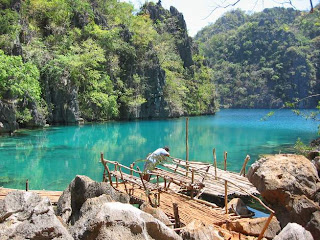
We lingered most of the afternoon in its peaceful beauty, listening to the birds sing, swimming, exploring the caves and floating and taking pictures . . .
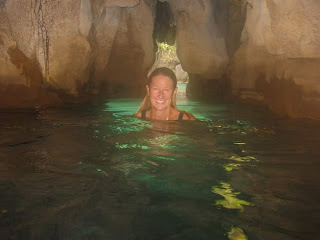
and more pictures . . .
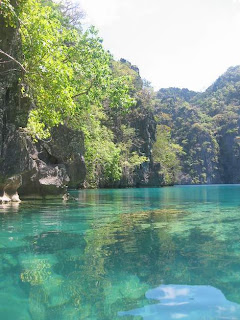
The water clarity was so impressive. Tiny needlefish checked us out and we watched them dart about. Shrimp occasionally nibbled on our shrivelled toes and ankles while we watched from the surface. We reluctantly got out of the water once we realized we'd been swimming for over two hours and our skin was ready to fall off. Eventually we left our little oasis to return by dinghy to our boat. We could have easily enjoyed another visit to this same magical spot or to another nearby lake in this remote pocket of idyllic peace and seclusion.
But that blasted immigration problem . . . We anxiously left Coron, crossing our fingers that we won't have another horrible sail only to get ripped off upon our arrival.

<< Home